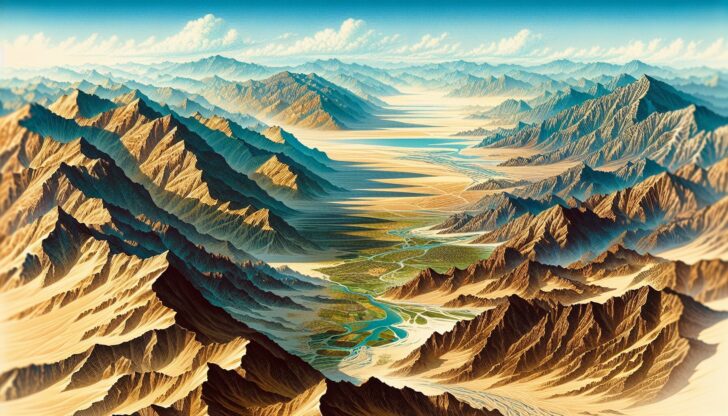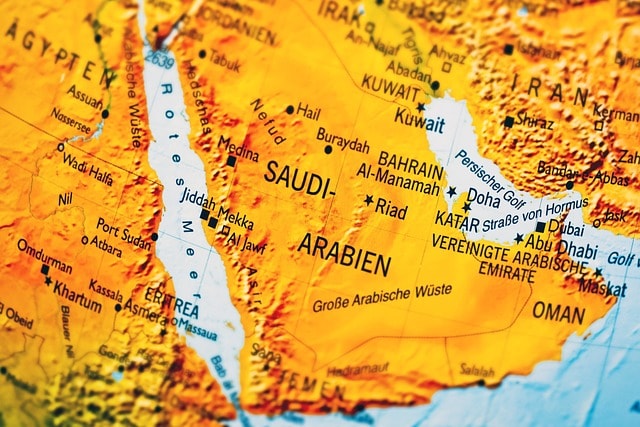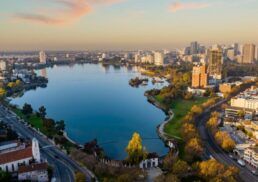Need a detailed map for the Middle East? This guide offers maps with information on geography, historical significance, and key countries in the region. Explore the diverse landscapes and rich history of the Middle East.
Table of Contents
Key Takeaways
The Middle East, a region defined by diverse geography, history, and cultures, serves as a historical crossroads for trade and civilization.
Geographical features such as deserts, mountains, and vital rivers like the Nile, Tigris, and Euphrates significantly influence the region’s climate, economy, and cultural identity.
Modern political boundaries in the Middle East are heavily shaped by historical events like World War I and European colonialism, leading to ongoing conflicts and complexities in political dynamics.
Defining the Middle East

The term ‘Middle East’ emerged in the early 20th century, replacing ‘Near East,’ which described the region closest to Europe. While some historically preferred ‘Near East’ for its proximity to Europe, ‘Middle East’ is now more widely accepted. The term has been criticized for being Eurocentric and colonialist, reflecting a Western perspective on global geography.
Geographically, the middle east region is a vast and diverse area, extending approximately 5,000 miles from west to east and 2,000 miles from north to south. This strategic location places it at the intersection of Europe, Asia, and Africa, making it a historical crossroads for trade, culture, and empires in the western middle east. The region encompasses a variety of physical landscapes, including deserts, mountain ranges, and coastal areas, each contributing to its unique environmental and cultural characteristics.
The Middle East has been the cradle of early civilizations like Mesopotamia, Persia, and Egypt. The term often overlaps with concepts like the Fertile Crescent and the Levant, enriching its historical and cultural context.
Recognizing the Middle East’s complexity, shaped by millennia of history and interaction, is essential.
Geographical Features of the Middle East

The Middle East’s geographical features are as varied as its history, encompassing deserts, mountains, and coastal plains. This diverse landscape significantly influences the region’s climate, human activities, and socio-economic development.
The geography of the Middle East, from the deserts of the Arabian Peninsula to the fertile valleys of the Tigris and Euphrates, plays a vital role in shaping its cultural and historical identity.
Major Landforms
The Middle East features extensive deserts, towering mountain ranges, and fertile river valleys. The Arabian Peninsula, for instance, is known for its vast deserts like the Rub’ al Khali, while the Zagros Mountains of Iran rise dramatically, impacting the regional climate and human settlement patterns. These landforms are deeply intertwined with the history and livelihoods of the inhabitants.
Rivers such as the Nile, Tigris, and Euphrates have historically been lifelines for the region, providing water for agriculture and supporting the growth of early civilizations. The fertile lands along these rivers enabled the development of some of the world’s first cities and empires, making them integral to the history and culture of the Middle East.
The geographical diversity of the region continues to influence its economic activities and settlement patterns.
Bodies of Water
The Middle East is bordered by several significant bodies of water that are crucial for trade, culture, and ecology. The Persian Gulf, for example, is a vital maritime route for the transport of oil, connecting multiple countries in the region and playing a key role in global energy markets. Similarly, the Red Sea, located between Africa and Asia, is an important international shipping route with rich marine biodiversity.
To the north, the Mediterranean Sea facilitates trade and cultural exchange with Europe, while the Arabian Sea to the southeast serves as a strategic route for shipping. These bodies of water have historically been central to the economic and cultural interactions between the Middle East and the rest of the world. Understanding these waterways is essential to grasping the region’s historical and contemporary significance.
Climate and Environment
The Middle East is characterized by its hot, arid climate, with extremely high temperatures, especially during the summer months. This arid environment presents significant challenges, particularly regarding water scarcity, which affects many countries in the region.
The harsh climate and limited water resources have shaped the agricultural practices, settlement patterns, and daily lives of the people in the Middle East, making water management a critical issue for the region’s future.
Countries and Territories in the Middle East

The Middle East is composed of several countries, each with its unique cultural, political, and economic significance. Countries such as:
Saudi Arabia
Iran
Iraq
Turkey
are key players in regional and global affairs. Egypt, with its ancient history and pivotal geographical location, continues to be a major influence in the region.
Additionally, the Middle East includes partially recognized states like Palestine, whose complex political status impacts their global recognition and the region’s dynamics.
List of Middle Eastern Countries
Commonly included countries in the Middle East are:
Egypt
Lebanon
Syria
Jordan
Israel
Iraq
Iran
Those in the Arabian Peninsula
These nations are culturally and historically rich, each contributing uniquely to the region’s identity. For instance, Egypt, with its ancient pyramids and historical significance, is a cornerstone of Middle Eastern civilization.
Other countries that are part of the Middle East include Bahrain, Cyprus, Kuwait, Oman, Palestine, Qatar, Saudi Arabia, Turkey, the UAE, and Yemen. Each of these middle eastern nations has its own distinct cultural and political landscape, contributing to the overall diversity of the region. Significant cities in the Middle East, such as Cairo, Istanbul, Tehran, Riyadh, Dubai, Tel Aviv, and Baghdad, are centers of culture, commerce, and politics.
The Middle East’s diverse array of countries and cities highlights the region’s complexity and importance in global affairs. From bustling metropolises to ancient historical sites, each part of the Middle East offers a unique glimpse into its rich heritage and contemporary significance.
Partially Recognized States and Territories
The Gaza Strip and the West Bank are territories with significant political and social implications, particularly in the context of the Israeli-Palestinian conflict. Gaza, currently under an Israeli blockade, faces numerous challenges, including restricted movement and limited access to resources.
The West Bank, on the other hand, is divided into areas of full Palestinian control, joint Israeli-Palestinian control, and full Israeli control, with about 500,000 Israeli settlers residing there. These partially recognized states have complex political statuses that affect their recognition globally and play a crucial role in the broader Middle Eastern geopolitical landscape.
The ongoing conflicts and negotiations surrounding these territories continue to impact regional stability and international relations.
Historical Overview of the Middle East
The Middle East has a rich and complex history, often described as a cultural crossroads influenced by numerous groups and historical events. The region’s history, from ancient civilizations to modern nations, is marked by empires’ rise and fall, religious movements, and significant conflicts.
Understanding this historical context is essential to grasping the contemporary dynamics of the Middle East.
Ancient Civilizations
Often referred to as the cradle of civilization, the Middle East is home to some of the world’s earliest societies and cultures. Ancient civilizations such as Mesopotamia, Persia, and Egypt emerged in this region, laying the foundations for modern society. The Sumerians, one of the first civilizations, developed around the 5th millennium BC in Mesopotamia, a region known for empires like the Assyrians and Babylonians.
The Achaemenid Empire, starting from the 7th century BC, dominated the Middle East, showcasing the region’s historical significance. The Euphrates and Tigris rivers, essential for fertility and agriculture, enabled the growth of early cities and trade networks.
The region’s rich history is reflected in the Fertile Crescent and the Nile Valley, known for their contributions to human civilization. The Levant, home to ancient civilizations such as the Phoenicians, added to the cultural and historical richness of the Middle East.
Key Historical Events
The Middle East has been the stage for many major conflicts that have significantly shaped its history and political landscape. The events include:
World War I
World War II
The Arab-Israeli Wars
The Iran-Iraq War
The Persian Gulf Wars
The Gulf War in 1990-1991, resulting from Iraq’s invasion of Kuwait, was a significant conflict that had lasting impacts on regional stability. After World War I, the Ottoman Empire’s territories were divided among European powers, redrawing political boundaries and creating new states in the Middle East.
The Sykes-Picot Agreement of 1916, which partitioned Ottoman territories between Britain and France, is a notable example of European influence on Middle Eastern borders. The British conquest of Egypt and the subsequent treaty that opened the Suez Canal to international trade further exemplified the strategic importance of the region.
The rise and fall of empires, such as the Ottoman Empire, have left enduring legacies that continue to influence the region’s political dynamics. The Iran-Iraq War and the Iraq War are other significant events that altered governance and territorial control in the Middle East.
Influence of European Powers
The influence of European powers on the Middle East became particularly pronounced after World War I. By 1914, the region transitioned from Ottoman governance to European colonial control. The Sykes-Picot Agreement, enacted after World War I, divided Ottoman territories between Britain and France, setting the stage for modern political boundaries in the Middle East. The British Mandate for Palestine, established after the war, marked a critical point in the region’s history and contributed to ongoing tensions.
The legacy of European colonialism continues to impact the Middle East, with many unresolved historical conflicts and territorial disputes stemming from this period. Today’s political landscape is deeply intertwined with early 20th-century European actions and decisions, highlighting colonialism’s long-term effects.
Learn more, visit WWI and the Middle East
Demographics and Cultures
The Middle East is a region of remarkable demographic diversity and cultural richness. Countries like Sudan and Tunisia, as well as other middle eastern country influences, are considered ‘transition countries’ due to their influence from both the Middle East and North Africa, leading to unique cultural landscapes.
One of the significant challenges facing the region is high youth unemployment, with over 25% of young people unable to find work, which poses a critical issue for future development.
Ethnic Groups
The Middle East is home to a wide array of ethnic groups, with Arabs, Persians, and Turks being the largest. Ethnic Kurds, primarily residing in Iran, Iraq, Syria, and Turkey, have faced significant challenges, including abuses and armed rebellions, highlighting the region’s complex ethnic dynamics. Additionally, the Middle East hosts numerous ethnic and cultural minorities, such as Jews, Assyrians, and Greeks, who have significantly influenced the region’s demographic landscape.
This diversity has resulted in a rich tapestry of cultures and traditions that vary significantly across the region. Despite the challenges, these ethnic groups have maintained their cultural identities and continue to contribute to the Middle East’s social and cultural fabric.
Languages Spoken
The Middle East is a linguistically diverse region, with major languages including Arabic, Persian, Turkish, Kurdish, Hebrew, and Greek. Arabic is the most widely spoken language, with multiple dialects reflecting regional variations.
In addition to these major languages, various indigenous and minority languages are also present, highlighting the region’s rich linguistic heritage.
Religious Diversity
The religious landscape of the Middle East is equally diverse, encompassing various denominations of Islam, Christianity, and Judaism. Many religious minorities exist alongside the dominant faiths, contributing to the region’s rich religious tapestry.
This diversity has played a significant role in shaping the cultural and social dynamics of the Middle East.
Economic Landscape of the Middle East
The economic landscape of the Middle East is heavily influenced by its vast oil and natural gas reserves, which make it a critical region for global energy supplies. The region’s wealth and economic stability are closely tied to the global energy market, affecting government revenues and development strategies.
Oil and Natural Resources
Oil and natural gas are the cornerstones of many Middle Eastern economies, providing significant revenue and shaping economic structures. Iraq, for instance, relies on oil and natural gas for 97% of its goods exports, underscoring the sector’s importance. The economic stability of oil-rich nations is highly sensitive to fluctuations in global oil prices, which can greatly affect their GDP.
Iran, Iraq, and Saudi Arabia possess the largest energy resources in the Middle East, making them key players in the global oil market. The Middle East accounts for about one-tenth of the world’s natural gas production, reinforcing its critical role in global energy supplies.
Other Key Industries
While oil and natural gas dominate the Middle Eastern economies, other industries also play significant roles. Here are some of them:
Agriculture, particularly in Egypt along the fertile Nile River, is vital for food production and rural livelihoods.
Tourism has emerged as an important sector, contributing significantly to the GDP of several Middle Eastern countries.
Banking and financial services are key growth areas, especially in nations like Bahrain and the UAE, which have developed robust financial sectors.
Notably, economic disparity exists within the region, with wealthy Gulf states contrasting sharply with less affluent nations. This disparity, exacerbated by reliance on oil and gas, highlights the need for economic diversification.
Political Dynamics and Conflicts
The political dynamics of the Middle East are complex and often marked by conflict. Since the founding of Islam in the early 7th century, the region has experienced significant conquests and transformations, impacting North Africa, Persia, and parts of southern Europe.
Understanding these dynamics is crucial for comprehending the region’s current political landscape.
Modern Political Boundaries
The modern political boundaries of the Middle East were largely shaped by the aftermath of World War I, which saw the division of the Ottoman Empire’s territories into various mandates and protectorates. The United Nations has mediated conflicts and established political boundaries, providing a framework essential for maintaining political stability.
These boundaries often reflect the historical and colonial influences of European powers, which continue to affect the region’s political landscape. The ongoing efforts of international organizations like the UN are vital for addressing the complex political issues that arise from these historical legacies.
Major Conflicts
The entire middle east has been the site of numerous major conflicts in recent history, each contributing to the region’s instability.
Some examples of the region’s intricate conflict dynamics include:
Shia government controls in east Iraq and west Syria
Sunni extremists in west Iraq and eastern Syria
The sectarian civil war in Baghdad since late 2012
The Syrian civil war, which erupted following the Arab Spring, involving multiple factions such as government forces, anti-government rebels, Islamist extremists, Kurdish militias, and ISIS
These conflicts have led to widespread displacement and humanitarian crises.
Tensions between Israel and Iran, particularly over concerns about nuclear weapons, add to the region’s volatility. The 2006 Lebanon War between Israel and Hezbollah resulted in significant infrastructure damage and displacement, further illustrating the impact of conflicts on the Middle East.
These ongoing conflicts highlight the challenges of achieving lasting peace and stability in the region.
Tourist Attractions and Cultural Sites
Tourism is an important economic sector for many Middle Eastern countries, contributing significantly to their GDP. However, political instability has historically led to declines in tourism, particularly during events like the Arab Spring.
Despite these challenges, the region boasts a wealth of historic and modern attractions that continue to draw visitors from around the world.
Historic Sites
The Middle East is home to numerous historic sites that reflect its rich history and cultural significance. Petra in Jordan, known for its rock-cut architecture and advanced water conduit system, is a marvel of ancient engineering. The Pyramids of Giza, one of the most iconic monuments in the world, are recognized as a UNESCO World Heritage Site and a testament to ancient Egyptian civilization.
Persepolis, the ceremonial capital of the Achaemenid Empire in Iran, holds significant archaeological importance and attracts researchers and tourists alike. These historic sites not only offer insights into the region’s past but also play a crucial role in its cultural heritage and tourism industry.
Modern Attractions
Modern attractions in the Middle East also draw significant tourist attention. The Burj Khalifa in Dubai, the tallest building in the world, stands as a symbol of modern architectural innovation and attracts millions of visitors each year. The Sheikh Zayed Grand Mosque in Abu Dhabi, celebrated for its stunning architecture, is one of the largest mosques in the world and a major tourist destination.
Visitors come from around the globe to admire its intricate design and the peaceful atmosphere it embodies.
Summary
In summary, the Middle East is a region of immense historical, cultural, and geopolitical significance. Its diverse geography, rich history, and complex political dynamics make it a fascinating area of study and exploration. From ancient civilizations and major historical events to modern economic and political challenges, the Middle East continues to play a pivotal role on the global stage.
Understanding the Middle East’s past and present is crucial for appreciating its future potential. As we have explored, the region’s unique blend of ancient heritage and modern development offers a compelling narrative that continues to shape the world today. We hope this comprehensive overview has provided you with valuable insights into the Middle East and inspired you to learn more about this remarkable region.
Frequently Asked Questions
What is the origin of the term ‘Middle East’?
The term ‘Middle East’ originated in the early 20th century as a replacement for ‘Near East.’ This transition reflected a shift in geographical and political perspectives during that period.
What are some of the major landforms in the Middle East?
The major landforms in the Middle East include extensive deserts, prominent mountain ranges like the Zagros Mountains, and fertile river valleys such as the Tigris and Euphrates. These diverse landscapes contribute significantly to the region’s geography and ecology.
What are some significant historical events in the Middle East?
Significant historical events in the Middle East include World War I, the Arab-Israeli Wars, the Iran-Iraq War, and the Persian Gulf Wars. These events have profoundly shaped the region’s political landscape and societal dynamics.
What are the main languages spoken in the Middle East?
The main languages spoken in the Middle East are Arabic, Persian, Turkish, Kurdish, Hebrew, and Greek. This diversity reflects the region’s rich cultural heritage.
What are some key modern attractions in the Middle East?
Key modern attractions in the Middle East are the Burj Khalifa in Dubai and the Sheikh Zayed Grand Mosque in Abu Dhabi, exemplifying the region’s architectural innovation and cultural richness.









